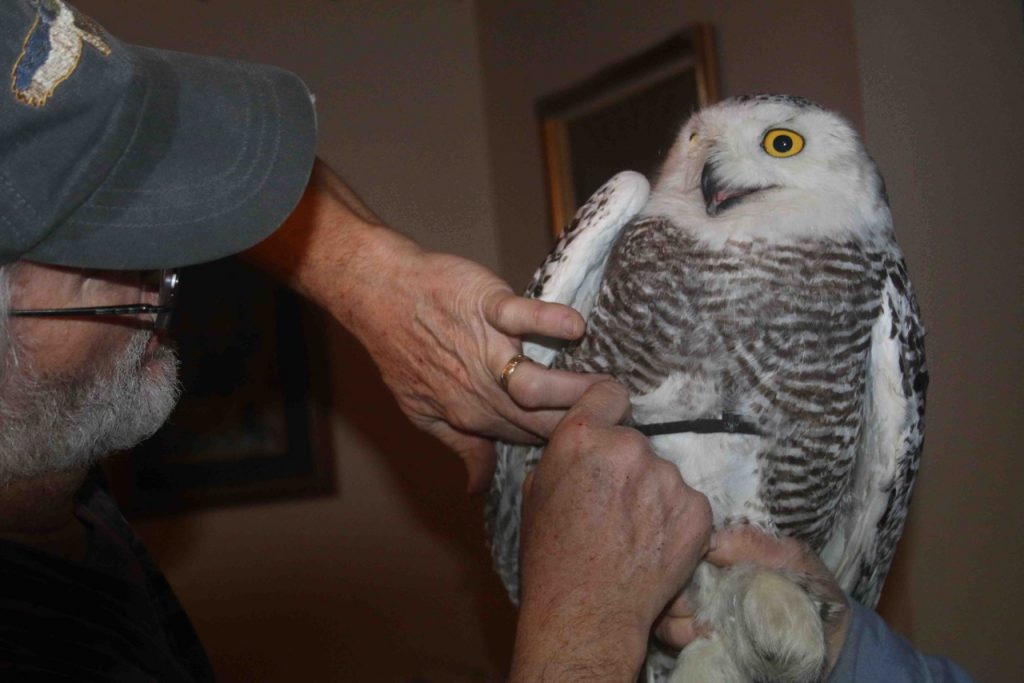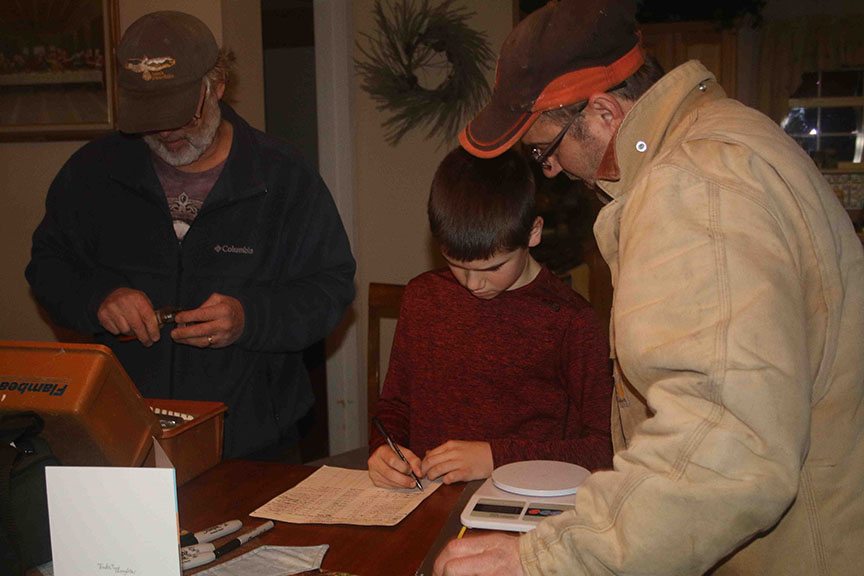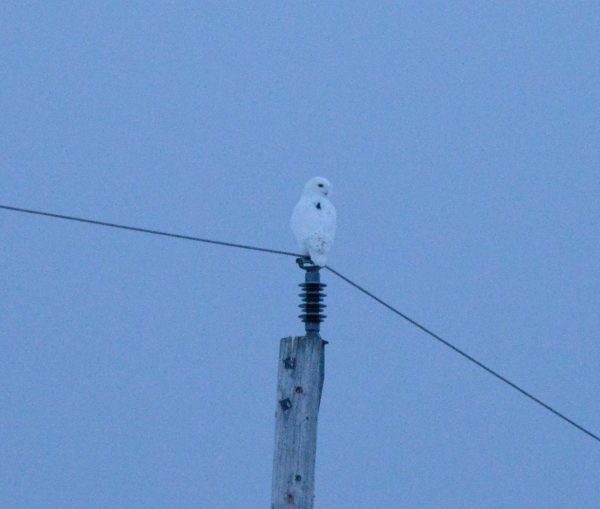
Tom McDonald adjusts the Teflon ribbon transmitter on Oswego, the newest Project SNOWstorm owl (©Beth Dubois)
Sorry for the silence — I’ve been leading a birding tour out of the country the past week and a half, but things were hopping at Project SNOWstorm while I was off the grid.
The big news is that we have our first newly tagged owl of 2017, caught by Tom McDonald on Jan. 19 at Oswego Harbor in upstate New York, along the southeastern shore of Lake Ontario.
“The harbor at Oswego offers an intriguing array of logistical challenges when it comes to trapping snowy owls,” Tom reports. “The long, rocky and inaccessible offshore jetties offer snowies a secure place to roost during the day. Several fenced-in government and port authority properties also provide safe havens for the owls during the busy daylight hours.”
“Experience has taught me that owls utilizing the harbor’s bounty are up off the ground and still in ‘hunting mode’ up to a couple of hours before sunrise. In order to be successful at this location, you need to be on location by 5:30 or 6 a.m.,” he said.
In this case, though, he was trapping at dusk, which is also a witching hour for snowy owls, when they first start their “day” of hunting. Tom had spotted a very heavily barred snowy owl hunkered down in weeds at the end of a fenced sand pile owned by the port authority.
“I used a hand-held predator caller to get her attention as I placed the lure into my net trap,” Tom said. “She traveled 300 yards across the open water to the small peninsula where I set up the trap.” In all, the actual trapping operation only took two minutes, once he was set up — one of those times when everything goes smoothly (and makes up for the many times when it doesn’t).

Connor Dubois, center, and his father Ray, right, help Tom McDonald prepare to band and harness Oswego — an unusual 13th birthday present for Connor and his twin sister Caitlyn. (©Beth Dubois)
The bird proved to be a juvenile female weighing in at a very healthy 2,121 grams (4.7 pounds). Tom performed the meticulous task of fitting the owl — which he nicknamed Oswego — with her Teflon ribbon harness and transmitter at the home of Ray and Beth Dubois. Their twins, Connor and Caitlyn, were able to observe — a pretty special way to celebrate their 13th birthdays.
Oswego was released about two hours after she was caught, with her fresh transmitter and a USGS Banding Lab leg band with the serial number 659-00461. We’ll be adding her map and tracking data in the coming days, so keep an eye out for them.
* * * * *
How about our other tagged birds? Not a lot of change there — Dakota, Baltimore and Hardscrabble seem to have settled down, at least for the moment, all on the Canadian side of the border.
Dakota remains among the wheat fields near Francis, Saskatchewan, a town of about 170 people (according to the Encyclopedia of Saskatchewan, which also notes that Francis has three churches, two grain elevators and indoor skating and curling rinks. Plus a celebrity owl).
She’s using a fairly limited area on either side of Rt. 33, an activity range that encompasses about 4 sq. km (1.5 sq. miles), stretching about 4.5 km (2.8 miles) from a stream drainage in the south to the edge of pasture land in the north.

A few owls habitually preen their back feathers over part of their transmitter’s solar panel, and that seems to be the case with Hardscrabble, who remains near Cobden, Ontario. (©Dan Lafortune)
Much farther east, Hardscrabble remains near Cobden, Ontario, close to the Ottawa River. His transmitter has been struggling a bit with the short days and low solar angle, and a photo sent to us by Patricia and Dan Lafortune (who have been great about keeping an eye on southern Ontario owls for us) shows why — he’s preened his back feathers up over part of his transmitter’s solar panel.
It’s a trait some of these owls have, and at this darkest time of the year, the feathers combined with a few days of bad weather can have an impact on the transmitter’s voltage. But the days are getting longer, the sun higher in the sky, and Hardscrabble’s charge is getting stronger all the time.
It’s been interesting to see how Hardscrabble, who spent last winter along (and at times out on) Lake Ontario, is sticking to an inland location this winter, hunting for terrestrial prey. He was mostly a land-based hunter last winter, too, even when he was roosting by day on lake ice, but we’ve had some owls (like Millcreek a few years ago) that did a Jekyll-and-Hyde switch from hunting waterbirds on the Great Lakes one year to sticking strictly with terrestrial prey the next.
And finally there’s Baltimore, who has also been a homebody, much as he was last winter on Amherst Island. This winter’s he’s settled down near Arnprior and Kinburn, ON, using a territory bisected by the Trans-Canada Highway, and similar in size to Dakota’s — about 3.25 sq. km (1.25 sq. miles). His favorite perch is a trio of large white pines, where the Lafortunes have found him many times in the past few weeks, sitting like a white sentinel atop the tallest tree.
There’s lots more news to share, but at the risk of being a tease, we’ll save that for the next update. Stay tuned, because things are really getting interesting…


2 Comments on “Oswego Joins the Crew”
I love this and just came across this article today. How is Oswego now? Do you have pictures of him to share with us that are interested? I think this is a wonderful project. ty for sharing.
Unfortunately, Oswego came to a bad end, colliding with electrical lines in Quebec while migrating north in May 2017. While tragic, when we lose tagged owls like this it allows us to document the hazards they face while down south in human-dominated landscapes.